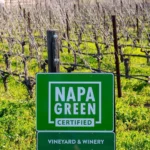How Napa And Sonoma Vineyards Are Going Beyond Sustainability To Embrace Climate Positive Goals
-
 Liz Thach, MW | Forbes
Liz Thach, MW | Forbes
- |
California wineries have long been leaders in environmentally friendly practices, because they recognized early on that wine grapes are one of the most susceptible crops to global warming. Indeed by 2019, 99% of Sonoma County vineyards were certified sustainable and 94% of Napa vineyards and wineries achieved certification under the Napa Green program. However, now both counties have established even more aggressive goals to reduce their carbon footprint and become climate positive – which is beyond carbon neutral, with negative emission reductions.
The sustainability certifications the vineyards achieved focused on efforts to improve the environment, employee working conditions, and economics – also referred to as planet, people and profits. Certifications were provided by third-party organization such as California Sustainable Winegrowing Alliance, Napa Green, and Fish Friendly Farming. However with so much progress, sustainability has become a new baseline for moving forward.
“Any continued actions we can take to reduce energy use in the vineyard and wineries will help to reduce our carbon footprint,” reports Anna Brittain, Executive Director for Napa Green. With this in mind, Napa Green has set a goal to work with certified growers to become carbon neutral within six years (2027), and carbon negative, or climate positive, within nine years (2030).
Sonoma County has also adopted a similar program called the Climate Adaption Certification Program. “We launched this program in 2020,” states Karissa Kruse, President of Sonoma County Winegrowers, and are working with local vineyards to administer best practices to maximize the sequestration of carbon emissions.” Some of these practices include reduced tilling of the soil, as well as planting more native shrubs around vineyards.
These efforts couldn’t come sooner, because the recent UN Climate Report has confirmed that global warming of 1.5°C to 2°C will occur as soon as 2040 if the world doesn’t take actions to reduce carbon (CO2) emissions soon. The results of global warming have already been witnessed in the increase in severe weather patterns such as wildfires, floods, and extreme frost/heat events that negatively impact agriculture. According to the EPA, the most effective way to reduce CO2 is to reduce fossil fuel consumption. It is also possible to sequester CO2 in the earth by planting more trees, plants, and cover crops.
About napa green
About Napa Green: The Napa Green 501c3 is a global leader in sustainable winegrowing, setting the highest bar for sustainability and climate action in the wine industry. Napa Green facilitates whole system soil to bottle certification for wineries and vineyards, and provides the expertise, boots-on-the-ground support, and resources to continually improve. Learn more at https://napagreen.org/participating-members/.
Anna Brittain
Napa Green
+1 805-636-3329
email us here
Visit us on social media:
Facebook
LinkedIn
Instagram



